"Everybody
gets everything he wants. I wanted a mission, and for
my
sins they gave me one. Brought it up to me like room
service. It was
a real choice mission, and when it was over, I'd never want another." |
Captain
Willard |
| Apocalypse
Now, the original 1979 cut |
|
If you've never tried it, you might be surprised just how
difficult it can be to write objectively about a film that you love, one that you regard as a work of pure cinematic
art. There is a constant temptation to overdose on superlatives,
to list every small thing about it that fills you with joy
every time you watch it. The result can sound horribly like
a critical dick suck, a fall to the feet of the filmmaker
with the cry of "I am not worthy!" But any true
film fan will have at least a fistful of films that she
or he holds so dear that all negative criticism is effectively
null and void. And so it should be. This is the magic of
cinema, that a film can so excite the watcher, whether it
be emotionally, intellectually or just for the sheer beauty
of the filmmaking, that for two or three hours the pairing
of the right viewer with the right film can lead to true
love. I'll admit that I have a lot more than a fistful in
my collection – at the last count it was approaching 400.
But if forced to sort them into order (and I have no desire
to try, thank you), there would be certain films that I
would have little trouble placing near the top. Apocalypse
Now is one of them. Perhaps I should be more specific
and say that I'm talking about the original cut rather than
Redux. But more of that later.
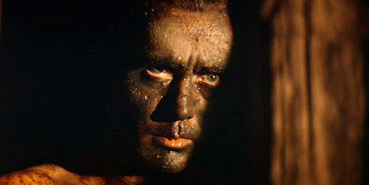
I
tend to assume that every film enthusiast has at least heard
of Apocalypse Now and that most have seen it,
but in the past three years I have learned not to be so presumptuous
about any film made before 1990. I have worked with teenage
students who would probably not even be of aware the original
Star Wars were it not for those wretched
new episodes – I tried once to use it as an example of the
narrative theories set out in Joseph Campbell's The Hero with a Thousand Faces and the entire class looked back at
me blankly. None had seen the film and several had never heard of
it. When I expressed my surprise, one of them remarked that they
didn't watch "old films." I pointed out it was
made in 1977, hardly the birth of cinema, and the reply
came back, "That was ten years before I was born."
To a young moviegoer still finding their way around the
films of the present, 1977 is ancient history. But I'm
going to stand by my presumption this time and warn newcomers
that there are some spoilers ahead, so proceed with caution.
If
you have seen it, then I hope you were lucky enough to catch
it in the cinema, and if you were really fortunate, as I
was, you'll have caught the original 70mm blow-up with its
quadraphonic soundtrack. It really is overwhelming on the
big screen. Visually it's consistently astounding
– one audience member at our film society screening of Apocalypse
Now Redux said to me in all seriousness, "That
is the most beautiful looking film I have ever seen in on
a cinema screen." This had as much to do with the quality
of the Redux prints as with Vitorrio Storraro's
cinematography – rarely have I seen colours this vivid,
images this precise on a projected 35mm film print. But
I'm getting ahead of myself. Let's assume you haven't seen
it and trot through a quick bit of plot.s
During the
war in Vietnam, young Captain Willard (Martin Sheen) is
sent on a mission to find and kill Colonel Walter E. Kurtz
(Marlon Brando), a Green Beret renegade who has gone off the rails
and set himself up as a God deep in the Cambodian jungle.
This basic premise, inspired largely by Joseph Conrad's Heart of Darkness, is used to explore a journey
into the darker side of the self through the experience of war from the viewpoint of the American combatant.
Willard travels up river on a PBR (Patrol Boat, River) crewed by,
in his own words, four "rock 'n' rollers with one foot
in their graves." Two are black – the almost underage
Clean (played by the then 14-year-old Laurence Fishburne) and the authoritative
Chief Phillips (Albert Hall) – and two of them white – the slightly wired Chef (Frederick Forrest) and laid-back surfer
Lance (Sam Bottoms) – who together serve as a microcosm
of the young American fighting man in Vietnam.
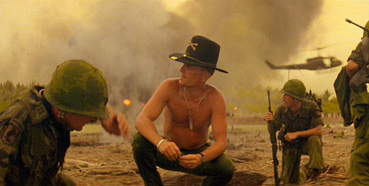
The journey undergoes a number of interruptions, each exploring
a different aspect of the American experience in the war.
The first is Colonel Kilgore (Robert Duvall), a
bullish, reality-detatched Air Cavalry commander who orders his men to surf under fire and plays Wagner over
loudspeakers as his helicopters attack a village. Then there's
the isolated floodlit supply centre ("a bizarre sight
in the middle of this shit!"), where GIs can buy drugs,
a motorbike, or a ticket to a show featuring Playboy Bunnies.
A darker encounter sees the crew stop a sampan to search for
weapons, only to end up slaughtering its occupants in a clear
reference to the Mi Lai massacre. All interesting enough,
at least on paper, but what is it that makes the film so
special? Oh, where do I start? Well how about the opening.
Picture the scene. We've been waiting for this movie for
years, and I do mean years. Shooting took something like twelve
months, post-production three times longer than that. The film went way over
budget and over schedule, and the movie press had taken
to dubbing it 'Apocalypse When?'. Stories of chaos and near
madness from the set had already become the stuff of movie legend, but
a screening of the incomplete film at Cannes had generated
huge excitement and earned the film a joint Palme D'Or win
alongside Volker Schlöndorff's The Tin Drum. Finally
the completed film arrived in the UK. It was due to go on
general release on 35mm in a few weeks, but for now was
playing only on 70mm in the big cities. I wasn't prepared
to wait and hopped on a train to London and the ABC Shaftsbury
Avenue and plonked myself in a prime seat near the front of the stalls.
I'd already become accustomed to a degree of audio-visual
joy at cinemas in London – I was there for the third
night of Star Wars and the second weekend
of Close Encounters of the Third Kind,
but this was to be a first for me. The
lights went down and the projector rolled. No image appeared,
but a strange, rhythmic electronic pulse started somewhere
at the back of the cinema and began drifting down the left
hand side towards the screen. Heads were turning in wonder
all around me. What was going on? By then we had an image
to accompany it, a static shot of a jungle tree line, and
as the sound reached the screen a helicopter drifted into view,
slowed down like the electronic representation of its rotor
blades we now knew we were hearing. As it departed
screen right, the sound of the rotor continued its journey up
the right-hand wall to the rear of the auditorium. This may sound all very well to those of you with home cinema
surround systems, but I'll wager that this is the first
time anyone in that audience had heard what was pretty much
the first cinema incarnation of what was to become the ubiquitous
5.1 sound of today. It was a revelation. But this was just
the start of it.
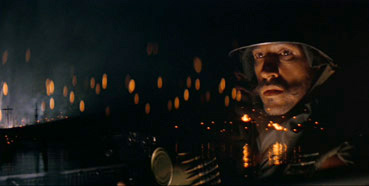
The
abstracted helicopter sounds were soon joined by the twangy
opening strains of The End by The Doors. I was
never a big Doors fan, but I always loved this track. As
Jim Morrison sang, "This is the end..." the tree
line exploded in napalm. Oh wow. The song continued, and
non-specific glimpses of warfare were overlaid with the
face of Martin Sheen, upside-down in frame, the helicopter
blades transforming to those of a fan on the ceiling of his room, a
brilliantly executed montage that was half character introduction,
half cinematic drug trip. One of the things I learned from
this DVD was that what must rank as one of the greatest
opening sequences in cinema history came about partially by
accident, and the Doors track was chosen because Coppola
thought "wouldn't it by funny to start a film with
a song called The End?" Like so much of the
improvised work in the film (the whole last act, for example),
Coppola appears to have been working with his subconscious
in overdrive.
"This
is the end..."
The
song seemed to predict both the film's narrative and the
politics of the war. The end of innocence for the crew of
the PBR, of Willard's desperate waiting for a mission, of
his understanding of his own role in the conflict, of America's
participation in it and its certainty of its moral high
ground.
"All
the children are insane..."
I
won't even START on the implications of that line. I had
always believed that the song had been chosen specifically
for it (teenagers in uniform, armed to the teeth, bombed out on drugs and caught
up in madness). That the music fades away just after this
line has been sung seemed to emphasise this.
Willard
is an immediately intriguing figure and remains so throughout
the film. His surface is impenetrable, his private torment
kept completely in check when sober and in company, his
military history as a skilled assassin only teasingly hinted at. No-one
in the film gets even remotely close to knowing or understanding
him, a privilege reserved for the audience through one of
the very best voice-overs ever created for a film. Written
by Dispatches author Michael Herr, it's model of poetic
economy that, as delivered in Sheen's mumbled growl, really
does seem to come from inside the character's head, a blend
of past tense recollections and musings on the here and
now that always feel personal, in part because of a choice
use of language. Consider his concise summing up of his
relationship history:
"I
hardly said anything to my wife until I said yes to a divorce,"
or
his description of Kilgore's Air Cavalry division:
"First
of the Ninth was an old cavalry division that had cashed
in their horses for choppers and gone tear-assing around
'Nam looking for the shit."
Gorgeous.
You don't think so? Maybe it's just me. Maybe you have to
hear Sheen say it, in context, blended with the sound effects
and the music. But then the sound design is a small miracle in itself,
primarily the responsibility of the great Walter Murch,
whose extraordinary montage work on Coppola's The
Conversation was as important to the plot as the
actors or the narrative. Sound effects, real and surreal,
are blended here with Carmine Coppola's alternately mysterious,
sinister, druggy and semi-abstract electronic score to take
us inside the experience of individual characters. Thus when
Willard, after surveying the madness around him, settles
down to concentrate on the report on Kurtz, the radio, the
shouts of the crew and even the throb of the boat's engine all fade
into the background to be replaced by the a few simple haunting
notes of score and Willard's voice over, delivered as if
he was sitting right behind you, softly speaking the words
into your ear.

The
journey encompasses a spread of Vietnam war experiences.
The astonishingly staged helicopter attack (I refuse to
believe this could be so impressively recreated with CGI
– certainly no subsequent film has ever come close to matching
it) vividly captures the doubtless very real excitement
of being part of such a well equipped assault force, but
slyly and disturbingly illustrates how easy it is to slip
in to the racist mindset that such combat inevitably encourages.
Almost every scene is similarly layered, simultaneously
advancing the narrative a commenting on the American Vietnam
experience.
Largely
cushioned from the realities of the fighting, the boat crew
initially treat the trip down river like a Club Med holiday,
sunbathing, water skiing, dancing to rock 'n' roll, toppling
the locals into the water with the wash from the boat like
the irresponsible adolescents they effectively are. They
are living a male teenage masturbation fantasy, equipped as they are with a
speedboat and an arsenal of big guns and set loose to do
their stuff. But hand a machine gun to a spaced-out teenager
and sooner or later he's going to shoot at the wrong people.
The
mid-narrative encounter with the sampan is a turning point
for the whole crew, especially the young Clean, whose macho
posturing with the machine gun is a clear extension of a
power kick he is not yet old enough to deal with. A sudden
move by one of the sampan occupants (to protect, it turns
out, a small dog she was hiding) is all that is required
to twitch his trigger finger and precipitate a massacre.
But the harshest lesson is delivered immdiately after by the battle-hardened Willard. When Chief realises that one of the victims is still alive and announces his intention to transport her to where she can receive medical help, Willard coldly shoots her and without a hint
of emotion tells him, "I told you not to stop. Now let's go."
From that point on, they know only too well that they are
in a war, and a dirty one.
Things
get darker still at the Do Lung bridge, a purposeless and purely
symbolic fixture that is destroyed and re-constructed on
a daily basis, guarded by the desperate and traumatised
and manned by drugged-out and leaderless black soldiers
who have effectively been ghettoised and abandoned by the
very army they are supposed to be fighting for. The final
outpost of American occupation and influence, beyond which
lies only Kurtz country, it is the absolute flipside of
the euphoric helicopter assault, an almost Dante-like vision
of war as hell. That the crew reach it in the darkness of
night seems only right – it's hard to imagine that the sun
ever shines here.
From
this point on the journey becomes increasingly and darkly
surreal, culminating in the arrival at Kurtz's compound,
where Dante gives way to Hieronymus Bosch and even Chef's
loud incredulity at the nature of Willard's mission ("We
gotta go up there so you can kill one of our own guys??")
is silenced by what he is confronted with. The descent into
madness is symbolised by Dennis Hooper's brilliantly twitchy
photojournalist, a wayward soul who is the crew's only initial
point of contact. When Willard is finally summoned, the
entire mission comes down to a philosophical face-off between
him and Kurtz.
Now
if most critics were supportive of the first two-thirds
(I say most because some of those who had attacked
it before even seeing it simply refused to back-track),
then the final act was to prove different story. The traditionalists
expected what they still saw as a war film to end with
a bang, and many felt that this hitherto fine movie completely lost
its way at this stage and effectively disappeared up its
own behind.
I
couldn't disagree more.
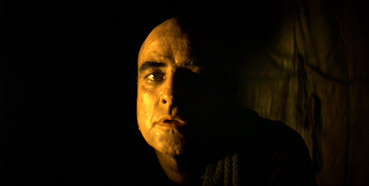
There
is a solid narrative and thematic logic to have a journey into
the soul that has been conducted largely in daylight and
in open spaces conclude in enclosed darkness. The decision
may have been forced on Coppola by the need to disguise
Marlon Brando's unexpected bulk, but as Coppola himself
remarks on the DVD extras, chance has always played an important
part in art, and it is clear that no decision here was taken
hurriedly or without considerable thought. Above all,
the scenes make for mesmerising viewing, Brando's own stories
and dialogue (told to the director, who incorporated them
into the script-in-progress) giving rise to some of the
most frequently quoted lines in the film. And even though self-consciously
overweight, camera shy and working from cue cards, Brando
still makes every single word count.
The
confrontation that follows may not be action orientated,
but it still builds to an astonishing cinematic crescendo,
as a suggestive assassination is intercut with the graphic,
real-life sacrifice of a water buffalo,* both victims dispatched
with machetes as a storm thunders overhead and The Doors
well up once again on the soundtrack. As Willard emerges
from Kurtz's compound and stands God-like before the assembled
tribespeople, I am on every viewing left feeling stunned and breathless.
No big climactic bang? Do me a favour.
As
their boat idles out of camp, the final, half-visible close-up
of Willard is a mirror reversal of the first, the same face,
the same man, but changed forever by his experience. The
70mm print ended at this point, a fade to black with no
end credits, preserving the rare cinematic poetry of the
piece.** The 35mm print that went on general release, on
the other hand, included an end credits sequence set against
footage of the destruction of Kurtz's compound, which was
misinterpreted by just about all of us as signifying that
the air strike we didn't think Chef had got round to calling
in had actually taken place, making a mockery of the film's final
call to disarm and let live. Later prints saw this replaced
by the simple white-on-black textual credits you'll see
here.
Apocalypse
Now does everything a great film should – it tells
a compelling story with superbly drawn characters and marvellous
performances, repeatedly takes chances and breaks new ground,
refuses to follow the obvious narrative arcs, and....oh
it's just superb. And yeah, there are a thousand little
moments that I could sit and get excited about – sit me
down with a bottle of wine and I'll tell you just what's
so marvellous about every shot and every edit in the film. Apocalypse Now is consistently magnificent
cinema and one of the finest examples I can name of a great
outsider film made within – albeit partially in spite of –
the Hollywood movie machine. Along with Stanley Kubrick's 2001:
A Space Odyssey, it remains the most lavishly staged art-house
film in movie history. It is work to treasure – we may never
see its like again.
It
was exciting news back in 2001, hearing that Coppola and
Walter Murch had gone back to the editing room to produce
a new cut of the film, re-inserting a hefty 29 minutes of
extra footage excised from the original release. We'd already
had a taste in the shape of snippets from a French plantation
sequence that had appeared in Eleanor Coppola's
riveting documentary on the making of the film, Hearts
of Darkness, and were intrigued by what else this
29 minutes might include. I use the term 'we' not in the royal sense
– just about everyone I know is a huge fan of the film and
this was a hot and frequent topic of conversation.
The
release date came and reviews were largely ecstatic, the
general feeling being that the recut had transformed a great
film into a masterpiece. Since I already thought it a masterpiece
I was getting pretty fired up by all of this. I was even
instrumental in organising the only cinema screening in
our area. The lights went down and once again the helicopter
once again moved around the cinema...
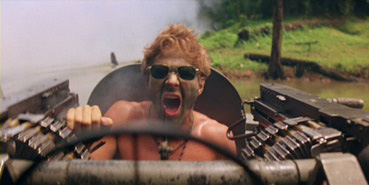
I
was and to this day remain uncertain about the new cut
and can think of several arguments both for and against
it. The most obviously positive aspect is that we get to
see this footage at all, and see it placed into the timeline exactly
where it was intended. The additions range from small expansions
of existing scenes to entirely new sequences. Some change
the way we read the scenes they precede or follow and in
one notable case the central character. All of the major
additions alter the flow of the narrative – whether these
alterations read as disruptions will be a matter for individual
taste.
I would certainly argue that one of them does. The
scene in question, the one I have the most issues with,
is an extension to the encounter with Colonel Kilgore, following
his notorious "I love the smell of napalm in the morning"
monologue. Played partly for laughs, it sees the crew steal
Kilgore's surf board and later hide the boat under the cover
of trees as the Colonel hovers above in a helicopter, suggesting they be reasonable and return the board.
Interesting in its own right, I have three particular problems
with the scene as it plays and fits into the narrative.
-
The
scene takes Colonel Kilgore, a previously larger-than-life
but nonetheless intimidating and oddly believable
character (many ex-vets have apparently told Coppola
that they thought he was based on their own commanding
officer) and turns him into a figure of fun. There
is an almost farcical element to some of his new bits
that sits uneasily with the surrounding material.
-
Wlllard is very much part of this prank and ends
up laughing with his shipmates as they make good their
escape. In this single moment, the image of Willard
as an impenetrable enigma accessible only through
his voice-over is effectively shattered, and for me the film
loses something as a result. Some may welcome this
glimpse of the human face beneath the cold exterior,
but it is the only example of the aspect of Willard's
personality and feels out of step with how he is presented
elsewhere. The very next sequence he's back to his
old self, like this little adventure never took place.
That said, this scene does put a different slant on
Willard's later killing of the woman on the sampan,
and his musing that "Those boys were never going
to look at me the same way again."
-
It breaks the flow of Michael Herr's narration, which
was clearly written for the original cut. The moment
in question occurs at the end of the scene as it originally
played. Following his monologue, Kilgore says encouragingly,
"Someday this war's gonna end," and gives
his version of a reassuring grin. Cut to the PBR crew
on their way again, and Willard muses, "Some
day this war's gonna end. That'd be just fine with
the boys in the boat." A simple but very effective
scene transition that is then developed further through
the voice-over that follows. As it plays in Redux,
though, the activity that occurs between Kilgore's
statement and Willard's reflection effectively
disassociates these two elements from one another, to such a degree
that you'd be pushed to recognise the link, at least
on a first viewing.
The
two other major additions both represent interruptions to
the journey, but this is at least in keeping with the original
structure. Whether these two scenes add or detract is debatable.
The encounter with the stranded Playboy bunnies comes close
to overplaying the comedy card again, but ends on a note
of considerable sadness. It's certainly an intriguing sequence and
I did wonder if my initial uncertainty with it was due largely
to having become used to the film without it, but Willard's
willingness to pause a journey he later kills to keep moving, coupled with his cheerful generosity to his crew, again sits uneasily
with the character as he is presented elsewhere.
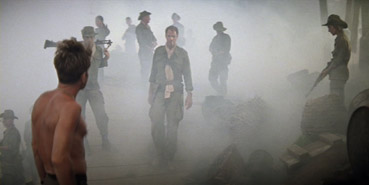
The
French plantation scene is a different matter. On my first
viewing I felt that of all the restored scenes, this was
the one that was most effectively integrated into the flow
and mood of the original. It's a long and talky sequence
that includes fevered political and historical discussions,
but there is a creepily effective sense here that the crew
have stumbled through a worm hole and into the past, first
suggested by the ghostly appearance of the plantation inhabitants,
emerging from the mist like the Elizabeth Dane crew from
John Carpenter's The Fog. Even Willard's
bedding of the mysterious widow sees him remain in character
– there is no joy, no passion to the scene, just a memory
from somewhere in his past that he is coldly reliving. A
few viewings in the sequence feels a little overlong and
by this point in the story the pull of Kurtz is distractingly
strong, but it is still a fascinating inclusion. I should
mention that at our cinema screening, a fair few of the
audience really hated this sequence and felt its inclusion
was a huge mistake.
The
final addition of note takes place in Kurtz's compound
and has Kurtz reading propagandist extracts from Time Magazine
to a severely weakened Willard, a scene that fits easily
with sequences that are already slightly disconnected from
each other by the unspecified passing of time. And any more
of Brando's Kurtz is always a good thing.
At
the end of the day Redux does stand on
its own merits and for me at least improved considerably
with subsequent viewings. But I'm going to have to take
view that is contrary to the one most commonly expressed
– Apocalypse Now Redux is a great movie,
but Apocalypse Now is a masterpiece.
OK,
let's get this out of the way first. Yes, the aspect ratio
here is once again 2:1 and yes, the film was shot in Technovision
at 2.35:1 and so yes, the image has been cropped for home
video. However, this is not a thoughtless act but an uncaring
distributor, but a process undertaken some years ago by the
film's director of photography, Vittorio Storaro. Whether
he shot the film with 2:1 in mind is still a matter of debate,
but Storaro has for some time been promoting 2:1 as the standard
aspect ratio for cinema in order to minimise the information
loss on 16:9 TV screenings, even proposing a new film format
as a result, to be known as Univisium. That we are not being
given access to the original 2.35:1 framing (or, if you saw
the 70mm print, 2.21:1) is still going to piss off a fair
few, myself included, but the high definition 2:1 transfer
supervised by Storaro with Coppola's full consent is now the
only source for all video versions, and so this is unlikely
to change, at least in the immediate future.***
The
good news, especially for fans of the original cut, whose
DVD incarnation was never up to that of the remastered Redux,
is that both versions look and sound superb, with contrast,
detail and colour all excellent, and black levels rock solid
with no loss of shadow detail. The 5.1 sound is equally
impressive, a very precise and very active surround mix
that very effectively recreates that original 70mm experience.
LFE bass work is also well used, the Arc Light sequence
sending thunderous rumbles around the room.
The film is actually spread over two discs and the likelihood
is that a form of branching was used to present two cuts
from essentially the same transfer. if so, the transitions
are seamless. No doubt the mid-film break will have those
who used to complain loud about 'flipper' discs in an uproar,
but given the film's length this presents no real problems.
The
packaging, by the way, is very nicely done, a confidential
dossier complete with seal housing a glossy fold-out package
containing the two discs.
The special features, like the film itself, are spread over
the two discs and of very impressive quality.
Spanning
both discs is the screen-specific Commentary
by director Francis Coppola. Now if you've picked up on
the advance press on this release, you may be aware of the
claim that there is a commentary on both versions of the
film. This is essentially true, but it's the same commentary,
it's just that on Redux there's more of
it. As you'd expect, it's compelling stuff, and despite
everything I've read and heard and seen about the making
of the film, Coppola still had a few surprises for me, from
the level of improvisation in the final scenes (he was pretty
much making it up as he went along at one point, inspired
by those around him and his paperback copy of Hearts
of Darkness) to a whole host of small details about
how scenes were devised, set up and shot. There are no dead
spots of any significance here – if you are a fan of the
film then this is the commentary you have been waiting for.
Disc
1
Watch
Apocalypse Now With Francis Ford Coppola (2:33)
is effectively a brief introduction by Coppola to the commentary
track, which you are then taken straight to.
The
Hollow Men (16:55) features a complete reading
of T.S. Elliot's The Hollow Men by Marlon Brando
as Kurtz, broken up and intercut with behind-the scenes
footage of the Kurtz compound sequences, shot by Eleanor
Coppola. It's a hypnotic, almost dream-like piece, and was
directed by a certain Francis Coppola.
Monkey
Sampan (3:00) is a downright surrealistic
deleted scene with a nightmare twist that is best to be
surprised by.
Additional
Scenes (26 mins total) features 12 additional
scenes, gleaned from what looks like timecoded VHS. All
are interesting and provide an intriguing glimpse of how
things might have been. Colby (played by Scott Glenn and seen
only briefly in the film) gets some dialogue and executes
Dennis Hopper's Photojournalist, Lance nearly falls victim
to a booby trap, and some interesting extensions are provided
to familiar scenes. One sequence I am seriously glad was
chopped has Willard cheerily introduced to the boat crew
in a rather cheesy superimposition.
The
AV Club is subdivided into four short featurettes.
The Birth of 5.1 Sound (5:47) looks at the
film's sound design and its pioneering use of what we now
know as 5.1 surround. It includes behind-the-scenes footage
of post-production work, and interviews with Walter Murch,
Francis Coppola and Ioan Allen of Dolby Labs, who provides
a very clear history of the development of cinema surround
sound (aided by some simple but very effective graphics),
and berates home cinema users for having their surrounds
and subwoofer turned up far too high...goddammit!
Ghost Helicopter Flyover (3:50) covers the
sound mix for that opening sequence that so dazzled us back
in 1979, and includes a neat graphical representation of
the speaker usage as you listen to the mix. Needless to
say, this featurette has a 5.1 soundtrack. "The
Synthesiser Soundtrack" by Bob Moog is
a detailed essay on the evolution of the film's distinctive
music track. Technical FAQ provides
some answers to a few commonly asked questions about the
film.
Redux
Marker activates a marker that appears on
screen when a sequence added for the Redux
version is playing.
Disc
2
The
Post Production of Apocalypse Now is subdivided
into three fascinating and substantial featurettes (well,
four, as such).
A
Million Feet of Film: The Editing of Apocalypse Now
(17:55) provides a concise and informative look at the editing
of the film, and includes interviews with all the main players
here and some more footage of the post-production work,
including of Sheen recording the voice-over and brief discussions
with scriptwriter John Milius.
The
Music of Apocalypse Now (14:43) is a wonderful
examination of the development of the electronic score,
a constant eye-opener that enhances further your appreciation
of just how much work and passion went into this film. It
includes more great archive footage and the revelation that
Coppola was at film school with Jim Morrison. The sound
mix, 5.1 again, is great.
Heard
Any Good Movies Lately? is further subdivided
into two sections. The Sound Design of Apocalypse
Now (15:19) continues in the style set by
the previous two featurettes, mixing interview with archive
footage to tell a compelling behind-the-scenes story. Sound
is once again 5.1. The footage of recording of sound effects
for the tracer attack on the boat is short but priceless.
The Final Mix (3:07) is a brief
but interesting trip back to the nine month long sound mixing
process.
The
final three featurettes are framed 4:3, short, and far less
detailed, but still of real interest.
PBR
Streetgang (4:10) is a collection of retrospective
interviews with the actors who played the PBR crew and includes
some pre-production read-through footage.
Apocalypse Then and Now (3:40) briefly looks
back at the Cannes screening, and Walter Murch talks about
re-editing the French plantation sequence for Redux.
The
Color Palette of Apocalypse Now (4:05) discusses
the Technicolor print that has resulted in the lovely transfer
on this disc.
Also
here is the disc 2 Redux Marker as detailed
above.
Impressively,
all of the extra features have optional English and Spanish
subtitles.
Subsequent
viewings and the re-availability of the original cut have
softened my view on Redux, which was initially
one of slight disappointment. I now regard it as a great
film in its own right, but will still go with the 1979 cut
every time. I am glad both are available and delighted that
both now feature equally impressive picture and sound. Whichever
version you prefer, this DVD release is an absolute must.
You could argue that without Eleanor Coppola's Hearts
of Darkness or the original 35mm credits it's still
a few notches short of the self-titled 'Complete Dossier',
but in all other respects this is one of the DVD releases
of the year – great film, great picture, great sound, great
extras. And you can pick it up on-line for about £10.
Seriously, what are you waiting for?
*
It will doubtless come as little comfort to animal lovers
to learn that this was not staged for the film, but a sacrifice
regularly made by the tribespeoplewho had been employed to play the inhabitants
of Kurtz's camp. Finding this out did prove to be personally
useful for pricking one bubble of anti-Coppola prejudice
following the film's original release. A fellow film student,
one who has done rather well in the industry since and thus shall
remain nameless, was cheerfully pouring scorn on all aspects
of the film. This sequence really came in for a lashing.
"And that sacrifice sequence," he bleated, "the
cow was so obviously fake!" On being told it was a
real sacrifice he became flustered and managed
to stammer out an annoyed, "Yeah, well, it LOOKED fake!"
I was curious to know how many real animal sacrifices he
had attended, just for reference. Strangely, I received
no response on that one.
**
Those attending the screening were given a handsome printed
booklet containing all of the credits and background information
on the production. I treasured mine and showed it proudly
to many of my fellow film students at the time, at least
until one of the evil bastards stole it from me.
*** The 2.35:1 framing was later restored for Optimum's 2011 Blu-ray release.
|